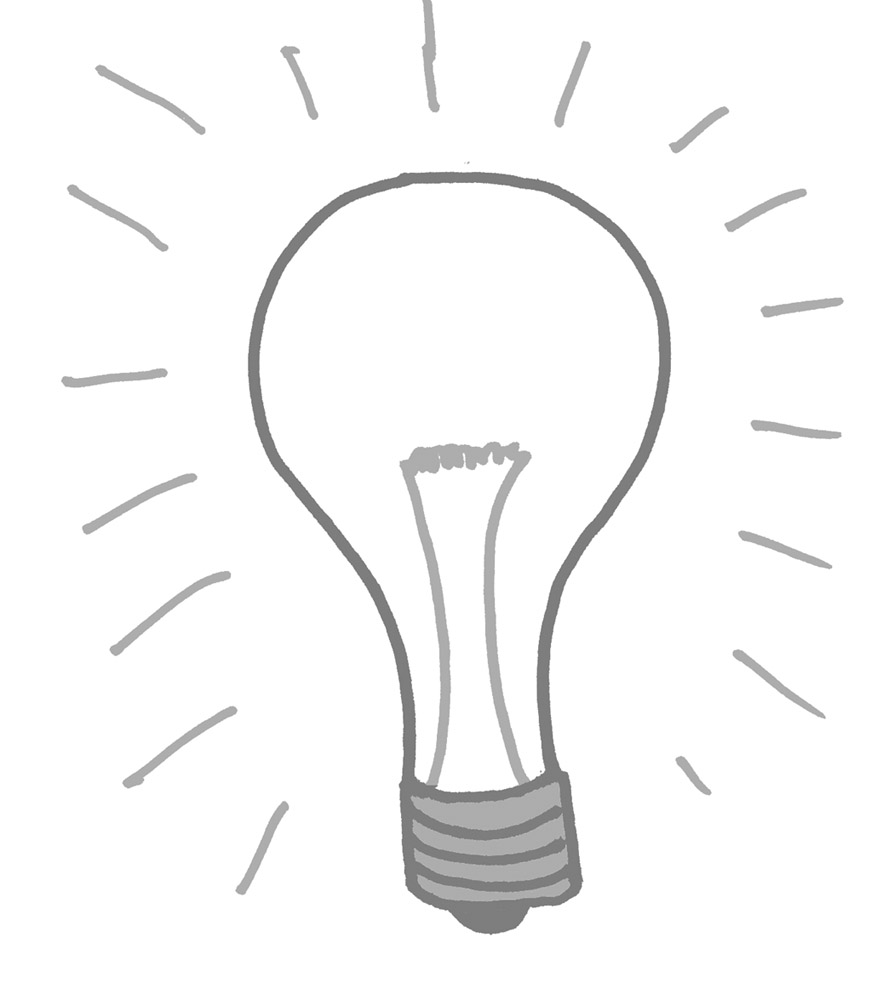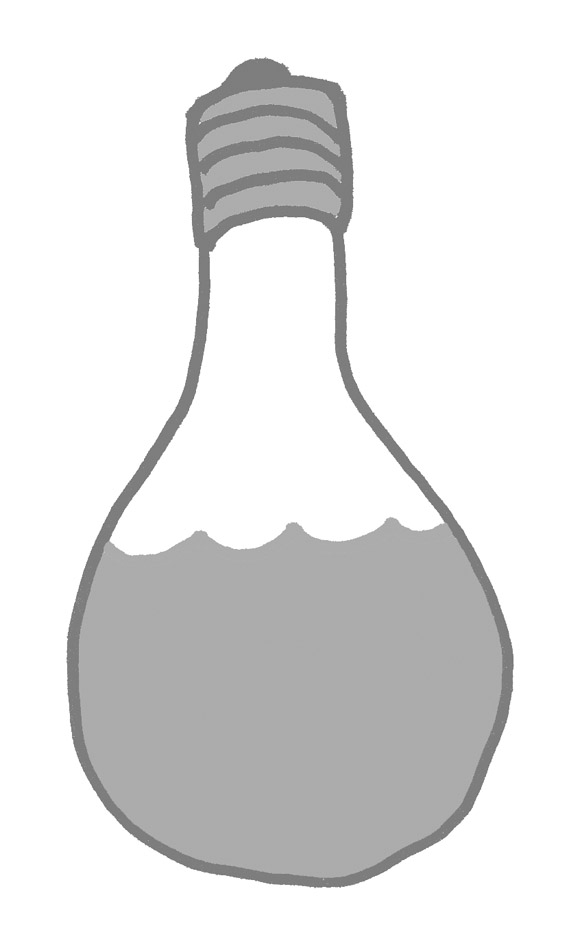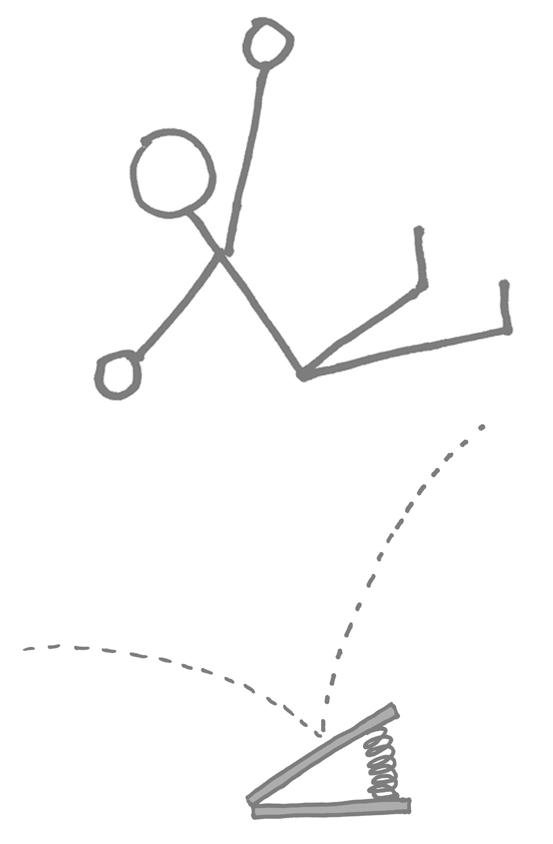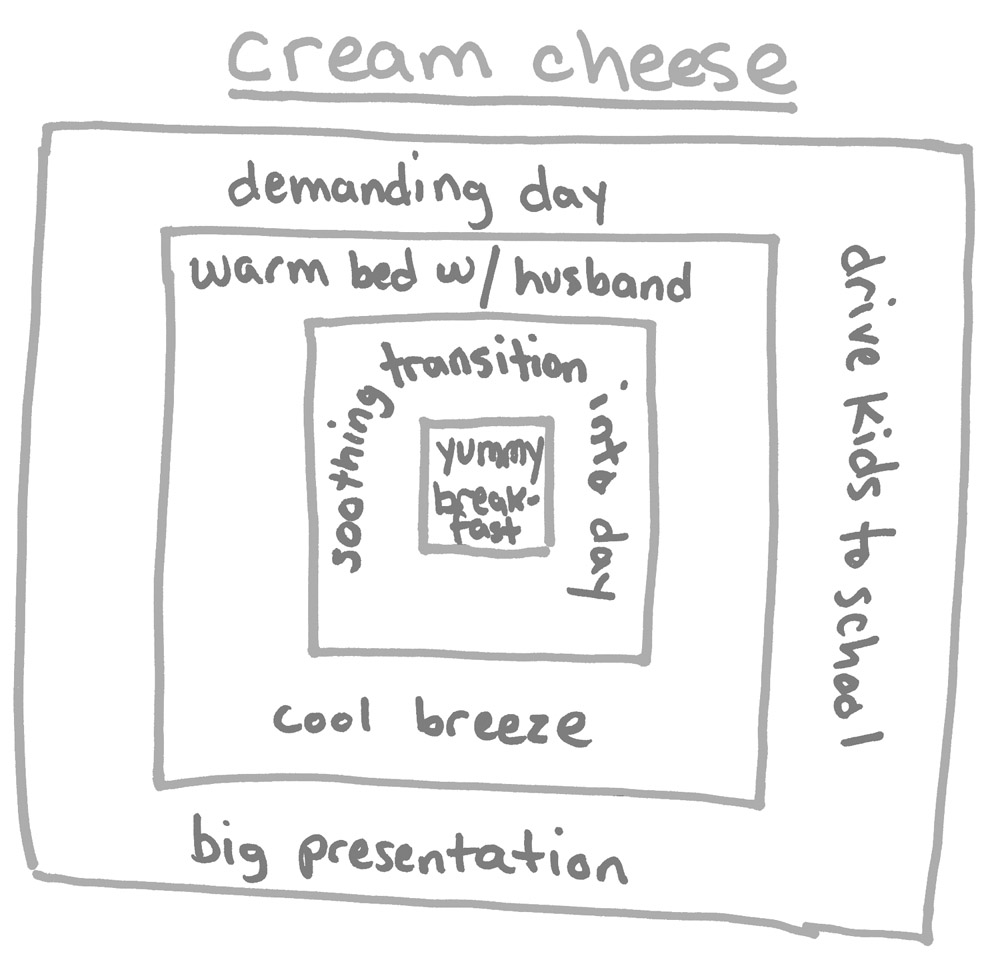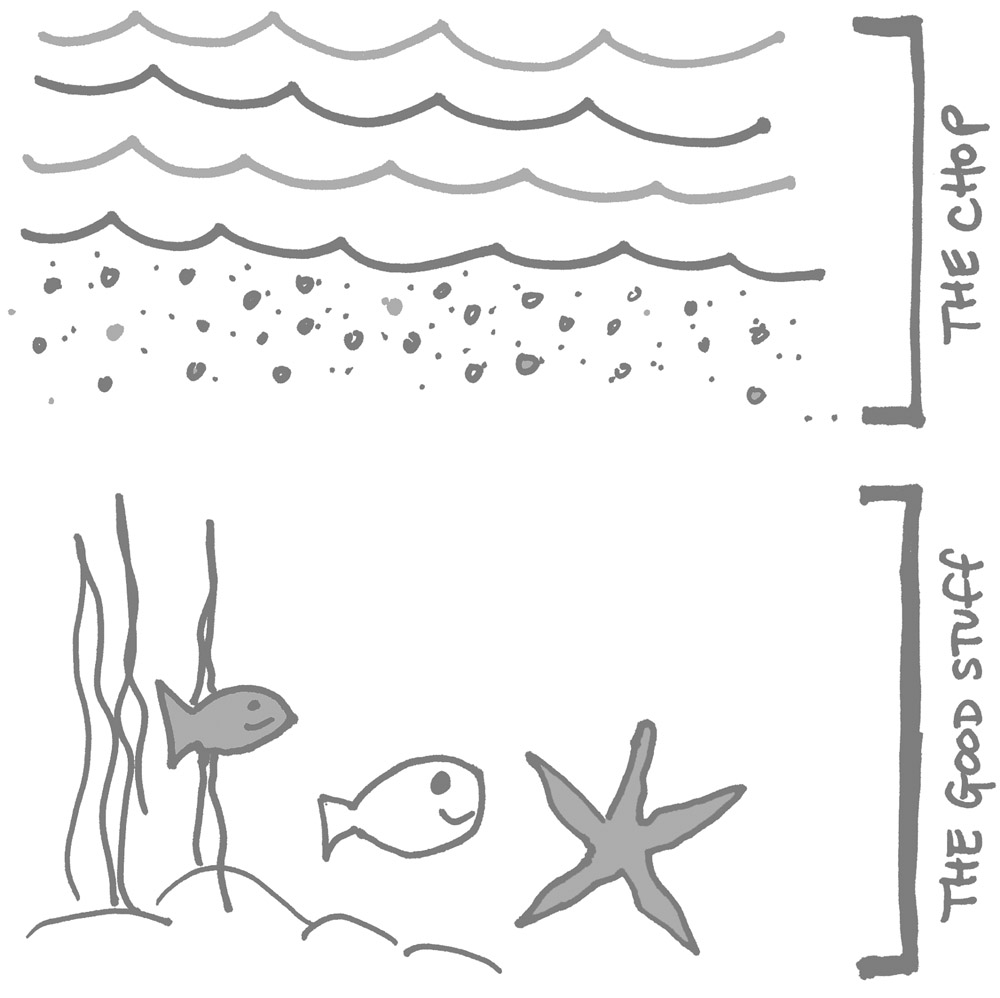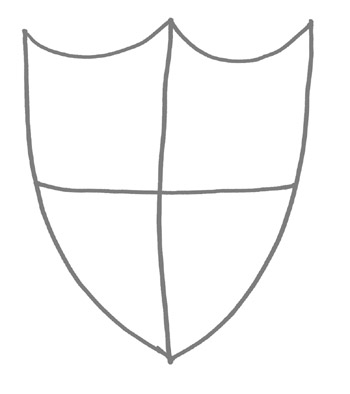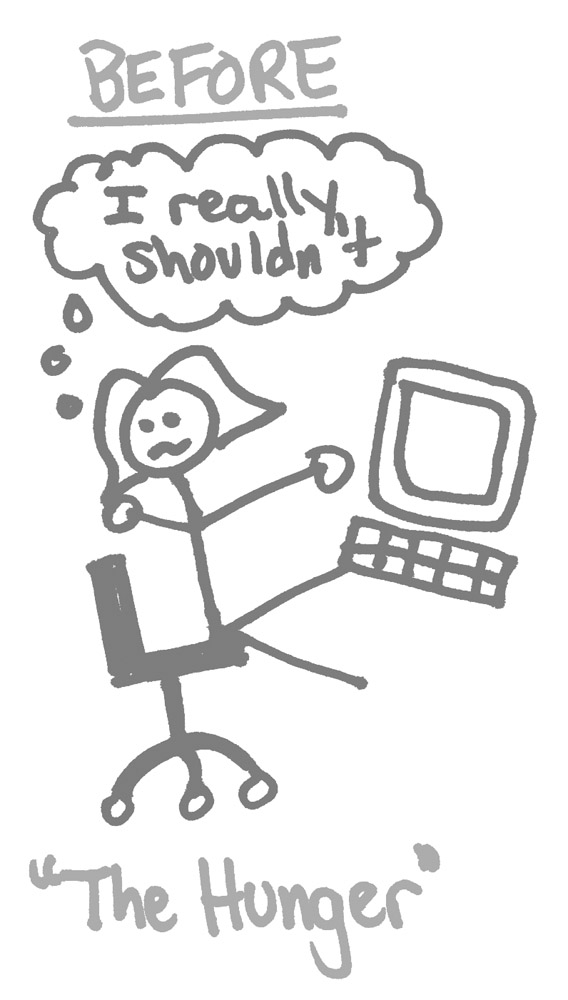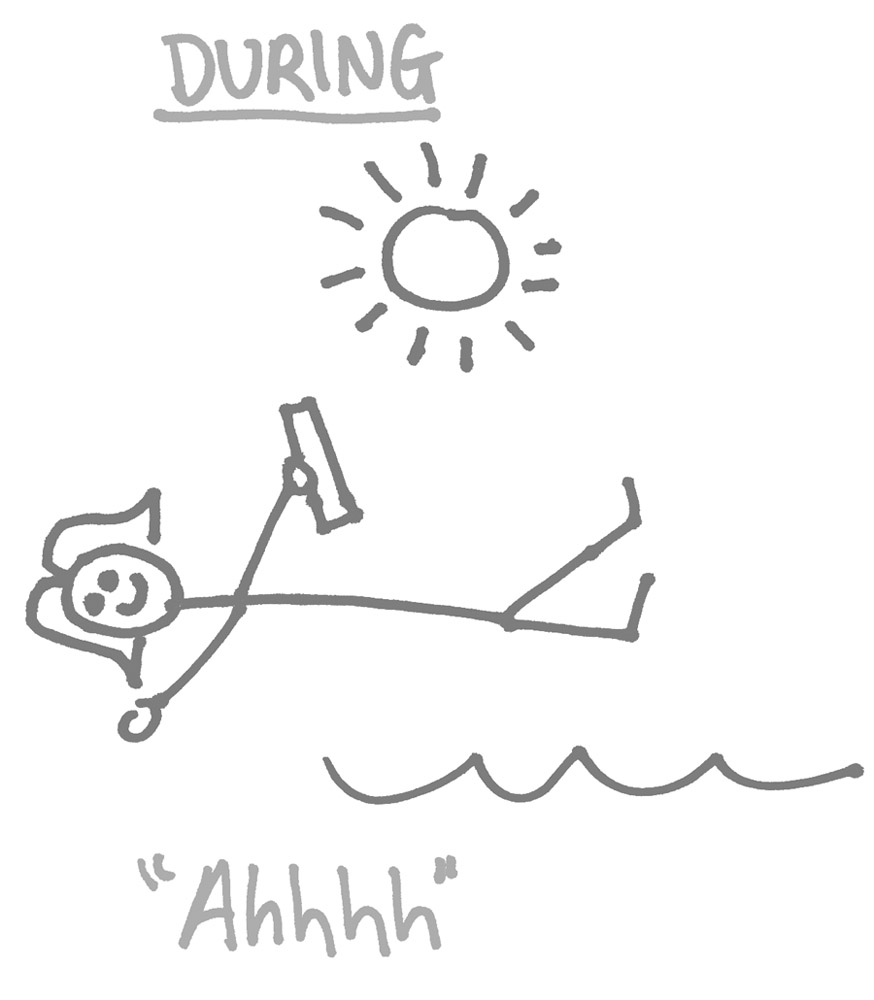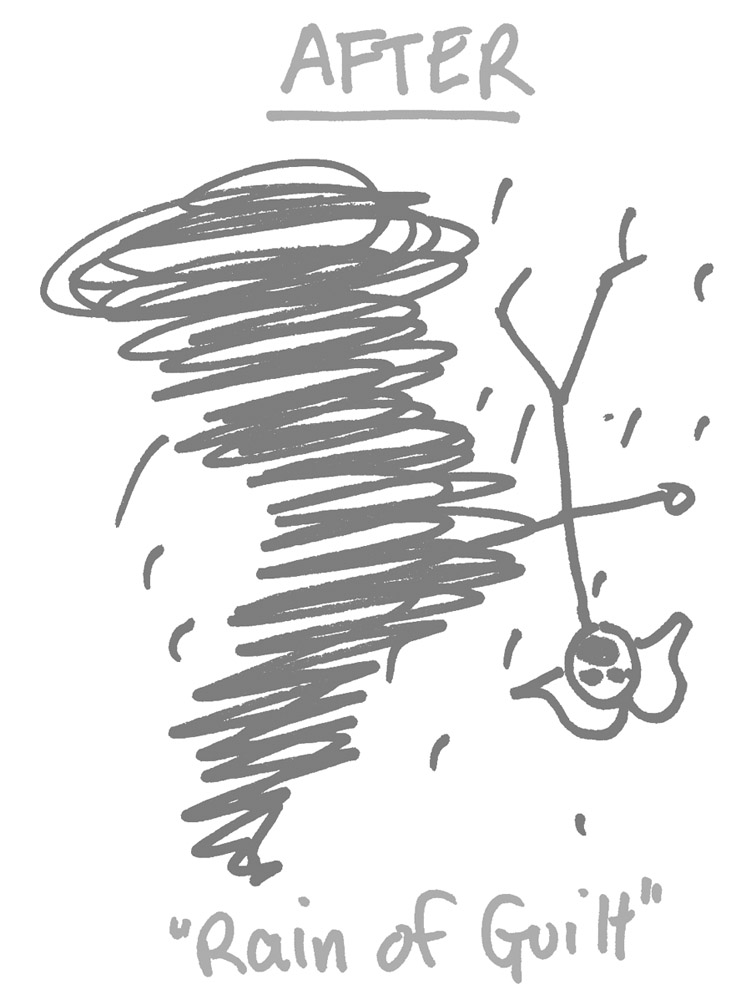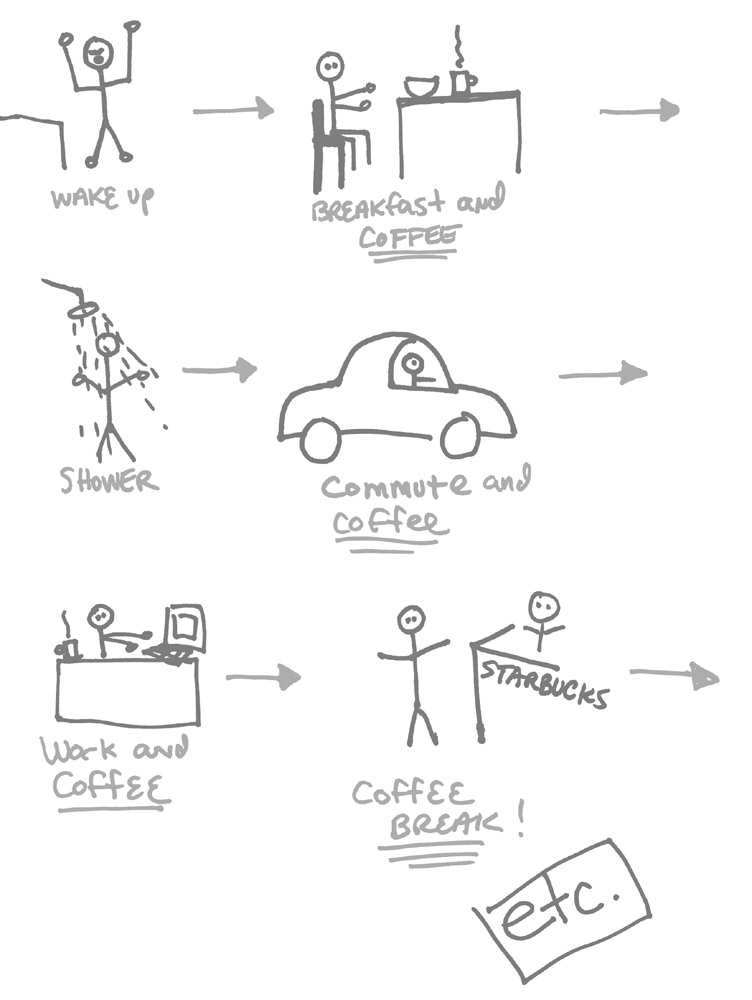Westside Toastmasters is located in Los Angeles and Santa Monica, California
Chapter 3: Asking Questions
Overview
So, we've looked at what creativity is and what the major obstacles to creativity are. The next step, you might think, would be to jump in and start dreaming up solutions to whatever problem you might be facing.
Ah, but not yet.
If you're trying to generate new ideas in business - new advertising concepts, new product development, brand revitalization - you're dealing with very specific kinds of problems. There are other people involved - clients and consumers - and finding a new idea is going to depend on how well you know these people. All energized ideas come from providing a fresh solution to a common, pressing problem. So the first step is to ensure that you know how your client/customer/prospect/consumer really experiences that problem and what it means to her or him. We need to experience the problem fully from these people's points of view, not from our own. That's where to start.
Before we go looking for answers, we left-brainers should be really sure that we've defined the questions correctly. Your consumers aren't thrilled with your new lemon-scented widget? Maybe you think you know why. Your market research seems to tell you why. But don't be too sure just yet.
Most market research is excellent at telling you what is (or what was yesterday) and how that compares to how things were earlier. This leaves it up to you to figure out what could be, what possibilities exist. Creativity is as much about framing the questions as it is about generating solutions (we're not going to say 'answers' because we're not addicted to finding answers - right?).
If you talk to the people you're selling to in a different, more generative way, you'll get relevant, energetic information that will be much more illuminating than the results of dry market research. Talking to people in this way is much easier (frankly) than sitting at your desk trying to think up something revolutionary by yourself, and it can lead to much more exciting results.
Everyone else's problems are your opportunities. Really. Repeat after me: Everyone else's problems are your opportunities to create innovative solutions.
Your ideas have to connect with the people you serve in powerful new ways if those ideas are to be successful. So do not start with the proverbial blank sheet of paper. There's nothing more intimidating and nothing more uninspiring. First, figure out whom you serve (or want to serve).
We all serve somebody. Whose issues do you care the most about? That's whom you should serve. So, once you've figured that out, I'll show you how to listen to those people in a creative way that will help you generate winning ideas. Get out and talk to people! That's where to start.
A Story Break
There's a story about Thomas Edison that has made quite an impression on me.
There was a mathematician who had the job of figuring out the volume of the lightbulb. Since it was an unusual shape, neither a sphere nor a cylinder, this wasn't an easy proposition. This man was very intelligent and well-educated, and he went about his task very conscientiously. According to the story, he consulted all his textbooks, he tried different formulas, he consulted all of his professors, and he consulted his professors' professors.
The mathematician was hard at work when Thomas Edison came in from a walk and said, 'You know, it's beautiful out there.' And the mathematician was thinking, Well, great; you're out taking a walk while I'm sitting here breaking my pencils working on this.
Edison continued, 'You know, I noticed this lovely pine tree. Did you ever notice that pine cones grow upside down?' Edison went to pour himself a glass of water, but instead of using a glass, he walked to the mathematician's desk, picked up the lightbulb, turned it upside down, and poured the water into it. He then handed it back to the mathematician and said, 'Here, measure the volume of the water.'
With any problem, I always advise people to turn it upside down. Look around you; get inspiration from nature; go for a walk; go outside. Don't just look at the task at hand.
Being and Doing
This chapter is all about asking questions in a way that will help you identify the fertile soil for innovation. There are two important components to this: the doing part and the being part. Many people will tell you the sorts of things you can do (tips, tricks, or techniques), but they don't pay much attention to how you can be-that is, what is the way of being that you should adopt in order to allow yourself to really be present in a room with someone and experience what it's like to be inside that person's skin.
How should you be in order to ask questions and really hear and comprehend the answers that you get?
The way we'll frame the discussion of questions in these pages is through the unique focus groups that I have developed for my clients, but don't limit yourself to that context as you explore the issue for yourself. I use these ideas all the time - whether I'm talking to my spouse or talking to clients. As someone once said, the key to all progress is asking the right question (doing) in the right way (being).
Most of the time, we think of action as straightforward. A man walks across the room and picks up a glass of water. A woman speaks to her employee. But actions themselves are usually the tip of the iceberg. Since most communication occurs nonverbally, actions can be multilayered and carry great weight.
In the film All About Eve, there is a scene in which Bette Davis's character argues with her boyfriend. Again, one would think that performing this scene would be straightforward: In an argument, one is angry. But strangely, for take after take, the actress couldn't convey the right emotion. She could 'do' the argument, but she had trouble with the 'being.' Finally, the director told her to seem during the argument as if she were dying to eat a piece of candy from a nearby bowl. The resulting scene sizzles with tension.
Exercise
Separating Being From Doing
Watch a video of your favorite movie and take notes. What are the actors doing, and how do they provide texture to the scenes by being? How would the scenes change if the actors took the same actions but were directed to be another way?
Really watch other people in meetings. Is there coherence between what they're saying and how they're being? What if they shifted their way of being? Would it change the meaning of what they're saying?
Look Around And Listen
Many people believe that the secret of getting great ideas is listening to that mysterious inner voice, that guiding intuition that offers brilliant mental suggestions to all those who know how to listen to it.
Well, yes and no.
That is the voice of your creativity, and it should always be honored, but uninformed creativity can often send you down the wrong path . . . the path of irrelevance. So when you're looking for that as-yet-undiscovered idea that will make you (or your client) rich and happy, don't start by looking inside yourself. Look around at the outside world first. Delve into other people's lives and psyches.
Author Frederick Buechner's definition of vocation is a true gauge of a great idea. He said that your vocation is when 'your deep gladness and the world's deep hunger meet.' Likewise, a great idea happens when what you have (tangible and intangible) meets the world's deepest hunger.
So where do you begin if you want to have a great idea? Stop counting the ceiling tiles, examining your navel, or staring at a blank laptop screen. Get out and talk to the people you're trying to reach! You can pick up so much in a face-to-face conversation with a consumer or a client, either one-on-one or in a well-crafted focus group, if you know how to listen to what that person is saying and process that information accordingly. The rest of this chapter is devoted to helping you develop proactive listening, the kind of rich, active listening that will create the fertile soil for great ideas.
Springboard Mentality
Of course, it's easy to think, 'I have an open mind. I'm ready to listen.' Unfortunately, we all have a bit of built-in arrogance. We've made it this far in life by trusting our instincts and imposing our own particular set of perceptions on the world around us. It's hard to let go of this.
Each time I conduct an interview, I try not to walk in with predetermined answers. I've always got some hypotheses that I'm curious about, but I never walk in with a particular result that I've already decided upon: 'The answer is Y' or 'These people are Z.' I go in with a springboard mentality: 'You show me what's cool here and where the energy is.' And when I do pinpoint the energy, that mindset allows me to turn on a dime and pursue it, often springing off in directions that I could never have predicted or imagined.
The Energy You Bring
Before I ask questions of a consumer or a client, I ask questions of myself first. Who do I want to be? What parts of my personality do I want to bring to this situation? In my case, I always want to be warm, friendly, funny, inviting, encouraging, and empathetic.
Every dialogue has two sides. Every interview is a transaction, an exchange. What will my half of the transaction be? What am I bringing to the table? What is the energy that I will evoke? Because energy transforms you-you aren't just acting, you're being.
So that's the first element of asking questions: Pay attention to how you are, what your presence is, what your energy is like. Think about how you are being in addition to thinking about what you're doing.
Exercise
Energy Doesn't Lie
Someone once told me that people can see through words, but that energy doesn't lie. Try these three experiments on energy and a springboard mentality and see if you can discover the truth in that statement:
First, try saying hello to the same person in three different ways (at three different times). Say it angrily, suggestively, in a friendly manner . . . how does the person react to each greeting?
Next, take this one step further. Begin conversations with three different strangers. These can be cashiers, neighbors you've never spoken to, or just people on the street. You can talk about anything you want to-talk about the weather or a sports team, or ask for directions - but the catch is, all the conversations have to be about the same topic, and you must start each one with the same opening line. The only difference is that you'll approach each person with different energy. You can be gruff, enthusiastic, timid, overbearing, or anything else you can think of. Notice how the other person reacts to you in each case - the differences that each kind of energy brings.
Finally, find three other strangers or people that you don't know well. Start conversations on different topics, and this time, approach these people with an encouraging and empathetic attitude that gets them talking. The trick here is to listen for the energy. They'll doubtless show some sort of spark when the conversation swings around to an area they're passionate about. Pick up on that spark and fan it into a flame. Follow the energy and see where it leads. Afterward, plot a trajectory for each conversation, pinpointing where it started and the direction it sprang off in once you teased out that spark.
Hold The Space
When I'm asking questions, I try to be conscious of all aspects of the experience, not just the information I'm trying to get at. There's a human aspect to the process of interviewing, a way of making people comfortable so that they will open up and feel free to talk. The phrase I use is 'holding the space.' When I 'hold the space' for these people, I'm present with them; I'm focused and interested and attentive.
I hardly ever take notes when I'm interviewing people. I can't really be present if I'm collecting notes. I will capture audio recordings, which are transcribed later. I nod, I supply all the appropriate body language, and, most importantly, I allow silence. I give people the room they need if they are to consider. I hold the space.
I also try to have the experience create value for the focus-group participants. I want them to walk out of the focus group with a sense of clarity that they didn't have before. I want them to have the feeling that somebody has actually valued what they had to say. When people feel valued, they open up more. They're more enthusiastic. They're more ready to give thought to what you're saying. It's a two-way street: When people feel valued, they provide value back to you.
The Big 'So What?'
So what are we listening for? While we'll get into this more in the Chapter 4, here are a few hints.
Pay attention to anything that the person you're interviewing has chosen to complain about. Remember the comment in the introduction about how, in any situation, you have to choose whether you're going to complain or create. If someone's chosen to complain about something, it could be because that person feels powerless to create a better solution or situation. What could you create that would take away the complaint?
Look for ideas that are antithetical to each other. For instance, someone might tell you in one breath, 'I want to be healthier,' and in the next, 'I don't want to change any of my habits.' The friction between those two ideas held by the same person is the potential energy for innovation.
Notice dis-coherencies, that is, things that are not coherent with each other. For instance, get really interested when someone is a very controlled person in almost every detail of his life but is wild in one particular area. Ask lots of questions about what's going on there. I've gone shopping with moms who are putting Pop-Tarts into the cart, while at the same time telling me that they're concerned about the amount of sugar their kids consume. It's fascinating to hear them talk about that incongruity. For many, their real concern is getting their kid to eat something (anything) before the child leaves for school. It's the lesser-of-two-evils choice. Aaaahhhhh, could there be an opportunity to create a breakfast product that kids will actually eat that gives them some protein so that they can concentrate longer at school?
Exploring The Context
Besides being present and alert, I always want to have the attitude of being open and curious-keeping a fluid point of view, in defiance of Enemy of Innovation Two.
One of the goals of this kind of consumer exploration is to explore the context of the answers. You may think you know why people are saying what they're saying, but as soon as you start to explore beyond the obvious, you discover the underlying connections, the way people put things together for themselves.
When I interview someone, I make sure that each response leads to another question:
Why is that important to you?
Where are you coming from with that?
That's really interesting. Explain to me what you mean by that.
How does that fit into your life?
Have you encountered that before? How have you solved that in the past?
With each subsequent answer, you learn more and more about the layers of context in the particular situation. People are motivated by contextual things, by the push and pull of their immediate environment. Most interviewers don't pay attention to context; they just pay attention to, 'How do you spread your cream cheese on your bagel?' They never think about the woman they are interviewing beyond her cream cheese preferences. They don't progress to wondering, where is this woman coming from? Does anybody do anything nice for her in her life? Does she get even two minutes a day to do anything for herself? What secret luxuries does she allow herself?
When you fully understand the context, you'll think about cream cheese differently. You can shake yourself free of your preconceptions about your product and the people who are using it, and begin to open your mind to new ideas.
We'll talk in Chapter 5 about how effective marketing shifts the emphasis away from the company and the product (the cream cheese) and toward the customer (how the cream cheese fits into her life, along with everything else). You can't do that if you don't have this sort of context.
Exercise
Creating Context
Make a list of the brand-name products you use everyday-deodorant, shampoo, cereal, peanut butter, candy, what have you. With each product, write down a short description of how you use it.
Next, draw a chart like the one here, with at least four concentric squares. Choose one of the products from your list and write its best quality in the center square.
Here's the fun part: In the next larger box, write what's happening that's relevant when you use the product. Then, in the next larger box, widen the aperture a bit and write down more of the context. Keep doing this until you get to the big picture.
Finally, compare this complex chart with just the 'how' part. See the difference? One narrows the inquiry, and the other provides any number of options for creative marketing. One is convergent, and the other is divergent. One is logic; the other is energy.
Spell It Out
Along with finding the context comes making it clear. Most consumer interviewers are fairly empathetic and intuitive, and can understand what's implied in the responses they get. The nuances and energy are often difficult to transmit to others, and clients may miss some important details. For their benefit, I ask consumers to spell out for me all the implications and correlations in whatever situation we're discussing. I ask them to imagine that I'm from Mars and to explain the situation to me as if I've never seen or done whatever is involved myself.
What exactly is going on here? If things are spelled out in a very literal and specific way, it's much easier to fully appreciate the information. When we ask people to spell things out in a more defined way, we also find that some of my assumptions weren't exactly on target, either. When your respondents expand their responses beyond a monosyllabic answer, you'll find that you gain a much broader, richer, deeper understanding.
Underneath The Chop
For me, the process of asking questions is akin to my experience as a scuba diver. On the surface of the ocean, there's always this kind of superficial, chattery chop. But once you dive in and pull yourself down the anchor line, you get underneath that chop, and you discover an amazing world down there.
This is what I always think about when I'm interviewing people: I need to find ways to get underneath that surface chop and down to that really cool world where there are a lot of currents and undertows and lovely coral that blooms at night and parrot fish. It's fascinating once you're there - you lose all your self-consciousness because what's going on around you is so amazing.
Imagining The Ideal
All the exercises that I use when I'm interviewing people - 'imagine this, imagine that, draw this, picture that' - are simply ways to get people to give me some indication of what their ideal would be.
I'll say to people, 'Oh, the real reason we're here is, I'm a wealthy venture capitalist, and I'm going to start my ideal fill-in-the-blank company.' I'm always intrigued by the results I get when people start thinking about what the ideal might be (rather than simply responding to what already exists).
While interviewing students at a university. I asked them, what would be the ideal food company for students? Right now, either they're captive to what's in the nearby vending machine or they have to walk 10 minutes to go to the student center, where the people are rude, the food is greasy, and the lines are long.
They said, 'Well . . . the food would be fresh.' 'It would be convenient.' 'It would come to us.' Then one student said, 'It would be on wheels.' Remember the technique of listening for energy? This was the comment that got the discussion crackling.
So then we started thinking about what's on wheels, and the image that evolved was a cart, like a tea cart. Somebody would come at class break times, every hour on the hour, and there would be smoothies and bagels and sandwiches and salads and fruit and baby carrots and every kind of healthy stuff. That was their ideal.
And then I had them talk about their current reality - what's really here? Well, it's greasy food and long lines in a dingy and noisy place with rude employees who don't listen and turn their back on you, or else it's packaged cookies and candy bars in the basement.
Judging from the excitement and energy while the students brainstormed about their ideal company, there's a good-sized business opportunity waiting for someone to take advantage of it.
Creating and Using Exercises
Sometimes, just sitting and asking questions isn't enough to get you underneath the chop to the ocean floor. On the following pages are some very powerful exercises that you can use to help you get at what's down there.
And because it's very important that you be familiar with these techniques before you use them, so that you can 'sell' people on them with confidence, there are instructions for how you can practice them on yourself and with a few helpful volunteers.
A Coat Of Arms
In an interview I will ask people to draw a shield on a piece of paper - a typical knight's shield, with a swoopy top and a heart-shaped bottom. I then ask them to divide it into four quadrants and draw something in each one of them, just like a coat of arms for a royal family.
They draw things that represent the qualities they think a particular brand has - anything that would symbolize those qualities. Imagine the difference between a coat of arms for Old Spice, say, and one for Axe. Or between a coat of arms for Lowe's and one for Home Depot. The nonlinear, emotional connections that people have with a particular brand often emerge on a coat of arms.
You can do this to imagine the qualities or activities of your ideal day versus your real days. The dis-coherencies are where the untapped energy lies.
Exercise
Coat Of Arms Analysis
Using the outline of the shield on the previous page, draw two coats of arms, each representing a different brand of the same type of product.
When you're done, without showing them yours, have two friends or coworkers perform the same exercise for the same products.
Then sit down with the two of them and discuss the results. Try to interpret their drawings before they explain them to you. Ask for confirmation. Listen for the energy and context in their replies.
This is a way of getting your intuitive / emotional right brain to comprehend the brand's personality. When you understand the product with both the intuitive and the logical sides of your brain, you have a better chance of making discoveries about it-such as what draws people to one brand rather than another.
Before, During, And After: The Three-Panel Cartoon
I'll have people draw a three-panel cartoon: They draw themselves before, during, and after an experience. They write their spoken conversations and a thought bubble of what's going through their minds, and they put a title on the bottom of each panel.
For instance, instead of saying to a 55-year-old man, 'Tell me about buying insurance for your family,' and having him respond, 'Well, I meet with the guy, and then I make a decision, and blah blah blah,' I have him draw a before-during-after cartoon. In the middle panel, the 'during,' what's coming out of the salesperson's mouth is all hieroglyphics, and the thought bubble by the guy's head is, 'What the hell is he talking about?'
In a traditional interview, would he ever tell me that? In an interview about snack foods, a woman went through this same three-panel cartoon exercise. In the first frame, she was sitting at her computer, thinking, 'I really shouldn't, oh maybe I will, what the heck.'
In the middle one, she was on a beach, on a 30-second vacation.
In the 'after' panel, she drew what she called the 'Rain of Guilt,' and it was as if she were in the middle of a cyclone.
The power of the image was intense. It's one thing to tell somebody, 'Oh, yes, people feel guilty after snacking.' But, when you look at the picture, filled with remorse and angst and all the ways she hates herself, you truly understand the emotion going on there and the level of intense energy that is just ripe to be tapped.
Exercise
Three-Panel Cartooning
Pick one of the earlier exercises in this resource, preferably the one that made you the most uncomfortable, and draw a before-during-after cartoon that describes the process of completing that exercise. Remember, give each panel a title and show your thought bubbles.
Next, ask a friend or coworker to draw a three-panel cartoon about another life experience: proposing marriage, giving birth, eating a new brand of cereal, or whatever.
Look for ideas that that person normally would not have expressed aloud. Again, we're accessing the right-brain emotional side and doing an end run around the logical, analytical, self-editing habits of the left brain. When you discover 'secrets' (like the Rain of Guilt), you have raw creative material that can be used in any number of ways. You're hunting for the unexpected, for the flash of insight.
A Path Through The Day
Sometimes I have people draw me a path through their day, from the time they wake up in the morning until they go to sleep at night. I ask them to show me their basic activities- how they spend major chunks of their time during a typical day.
They draw little stick figures: here I am eating breakfast, here I am going to work, here I am at work at my little stick-figure computer, here I am eating lunch, here's my cigarette break.
Then, with snack users for example, I would ask them to draw in where they had a snack and how it changed the path of their day. You could see the particular pattern that emerged: People were carving out momentary oases in a busy day, retreating from the usual path of routine. This is a great exercise for any regular habit or product use that you want to explore, and the actual moment of the activity can be further illuminated if necessary by using a three-panel cartoon.
Exercise
Mapping The Path
You guessed it! Based on this example, it's time to have someone draw a map through his or her day. Decide in advance what behavior you want to look for, and ask the person to include it: coffee or soda drinking, gum chewing, snack eating, and so on. What insight do you get into this person's habits and life? What surprises you?
The Internal Weather Report
When my son was little, I tried to teach him how to talk about his emotions, which is a hard thing to do. When my older daughter was young, she would tell me everything: 'Hmm, I was feeling a little grumpy earlier today, but now I'm more calm,' but my son would answer in single syllables.
'How ya doing?'
'Fine.'
'Fine? That's it? Just fine?'
'Fine.'
So I'd ask, what's the internal weather report? Is it sunny, is it cloudy, is it lightning bolts, is it a cyclone, is it a hurricane? What's happening on the inside?
These days, I'll tell the story about how I got my little boy to talk about his feelings, and then I'll have people draw their internal weather report, using the weather symbols. I ask them to add these symbols to the path through their day (previous exercise).
I did this on a few occasions with teenage girls. You always hear that their peers are really important to them, but this exercise really illustrated the depth of that feeling.
I had them draw a path through their day, noting especially when they spent time with their friends. Then, at each activity, I had them draw in a tiny internal weather report. The only time there were little sunshine icons was in the moments in the hall between classes when they were with their friends and after school when they were with their friends. At night, when it was time to go to bed, one girl drew rain because she was sad that she wouldn't see her friends for another eight hours.
How does all this connect with creativity? All of these exercises bring you a greater and clearer understanding of someone else's mind and point of view. You become their advocate. You think, 'If I were in this person's place, what would I want and need?' The more you can humanize and add dimension to the people you're talking to, the more real they become.
We're good at reducing people to numbers ('Tweens drive up to X-Y% of family purchases!'), but not so good at understanding the real emotions that drive people. Marketing based on numbers feels logical-analytical-left brain. When you're truly in touch with the people you're trying to communicate with, you're accessing that emotional-intuitive side, the side that can't be analyzed.
Exercise
Drawing The Internal Weather Report
The internal weather report is another great tool. Have the friend who helped you with the previous exercise pencil in the weather icons for each activity on his or her path through the day.
For extra credit, you may have the person do a three-panel cartoon for each time he or she engages in the activity you're measuring.
Put it all together, and what have you got? Certainly a lot more than you would have if you'd sat the person down and asked, 'Tell me about your experience with your breakfast cereal.'
From Executives To 12-Year-Olds
We weren't sure what the response would be to these kinds of exercises. Would drawing a cartoon be too 'out there' for people to really engage in? Who is really going to draw me an 'internal weather report' and take it seriously?
Well, everyone.
Interestingly, we find that people just dive in and do them, whether the audience is executives or one of 12-year-old girls. That broad willingness to respond just proves the effectiveness of having an open and curious attitude. The process is about the person you're questioning, not about you. You hold the space, you introduce the questions and the exercises, but it's the people you're listening to who take you below the chop, who reveal what's in the world below the surface.
It becomes your task, then, to listen for the energy, to look for associations, to find connections that other people might not have made before. By doing this, you can proceed to the next step: releasing potential energy.




